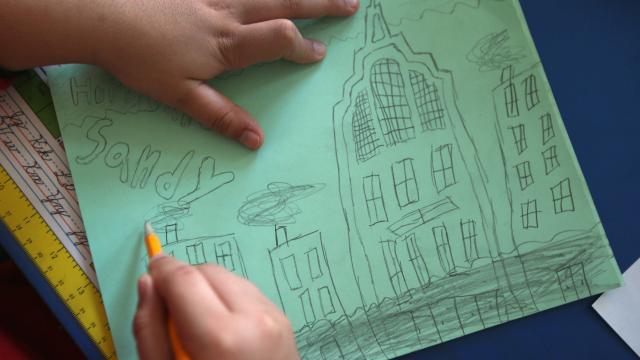Mental health and natural disasters may seem like something that doesn’t need too much scientific research: It seems obvious that going through a terrifying hurricane, especially if you’re young and impressionable, could really mess a person up. But it looks like we may need to prepare more than we thought for helping kids weather some tough times as the planet warms. A new analysis published on Monday in JAMA Network Open finds that up to half of all children show some form of post-traumatic stress symptoms after hurricanes hit.
It’s well-established that after disasters, children have reported problems with mental health, physical health, and their learning, said Betty Lai, a professor of developmental psychology at Boston College and one of the authors of the new paper. Experts also have known for a while, Lai said, that kids can develop post-traumatic stress symptoms like flashbacks, nightmares, heightened fear and distress, and changing behaviours to avoid reminders of the event following natural disasters.
But, Lai said, there was an issue with how experts framed the question of kids’ responses to disasters. “In the past, the way that we analysed children’s responses to disasters was trying to figure out what was the ‘average’ reaction a kid would have,” she said. “Turns out, that’s not quite the right question to ask, and that’s why this study matters.”
[referenced id=”1333964″ url=”https://gizmodo.com.au/2020/08/save-the-schools-save-the-youth-save-the-world/” thumb=”https://gizmodo.com.au/wp-content/uploads/2020/08/28/gc6jhbzgckvtzrugje3w-300×169.jpg” title=”Save the Schools, Save the Youth, Save the World” excerpt=”In another life, I may have been a teacher. I have a soft spot for the youth, especially the tiniest ones who don’t yet know what they’re in for. That’s probably what troubles me most about this world and all its problems: what, exactly, are we going to be handing…”]
The analysis combines data from four separate studies on the mental health of children in the aftermath of Hurricanes Andrew (1992), Charley (2004), Ike (2008), and Katrina (2005). The four studies in question followed more than 1,700 children between the ages of 6 to 16, recruited from schools in Texas, Florida, and Louisiana that were near or in the path of at least one of these storms. The studies kept track of them from three months to up to 26 months after the disaster.
“We really recognise that children have many different reactions to disasters,” Lai said. “This modelling lets us understand what are different typical patterns of reactions that children have.” By standardising data across the study, Lai and other researchers were able to pull out what happens to different kids from different kinds of disasters over time.
The analysis found that very few of the kids experienced “chronic” symptoms of post-traumatic stress. Still, around 10 per cent of the children in the survey experienced symptoms that started out intense and didn’t go away over time, requiring more serious interventions. The study also showed that there was little evidence of kids who suddenly developed intense symptoms months out from the disaster.
But a majority of kids, the study found, experienced a middle type of post-traumatic stress. Their symptoms of stress either started out intense and decreased over time, or they stayed at a lower level over the same time period. And just because a child’s mental health symptoms aren’t the most severe doesn’t mean they can’t be disruptive: recurring thoughts about a hurricane, trouble sleeping, or difficulty concentrating can impact learning and attendance.
“Even those middle-of-the-road symptoms can cause distress for kids,” Lai noted.
The data also showed that age seemed to be an insulating factor against chronic symptoms; the older a kid was, the more likely they were to have less distress after the disaster. Lai said experts are still trying to figure out how exactly age factors into the symptoms a child may develop after a traumatic event.
“It’s not until middle school and high school that kids have a better sense of an abstract meaning of life and how this all fits together,” she said. “Sometimes we see more severe reactions in elementary-aged kids. They have just experienced less of life, so a huge event has impacted a larger portion of your life. You have fewer experiences of not having this horrible event happen to you, and less context for how to understand it.”
And as weather-related disasters get more intense and frequent with climate change, it’s important to be prepared and act quickly to protect kids of all ages. Storms are already intensifying more than they used to. Though the study didn’t look at flooding, wildfires, or extreme heat, these climate change impacts are becoming more common and disruptive, too.
“We’re seeing these patterns really early on, three to six months post-disaster,” Lai said. “But a lot of times the intervention in terms of mental health doesn’t come until later. What this is telling us is that we have to assess early and then triage. We can’t just hope symptoms will go away.”
